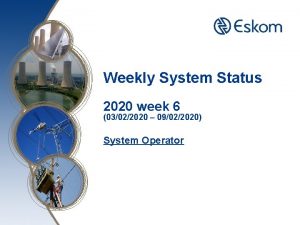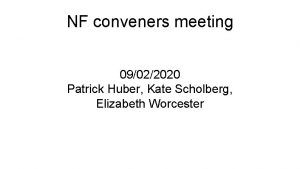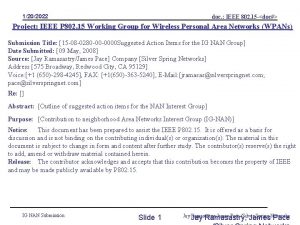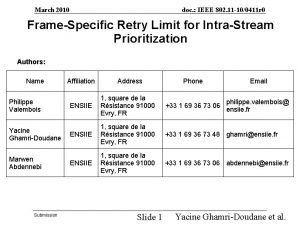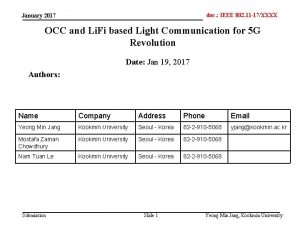09022020 Doc IEEE 802 11 201058 r 1










- Slides: 10

09/02/2020 Doc. : IEEE 802. 11 -20/1058 r 1 Low Latency Support Date: 2020 -09 -02 Authors: Name Affiliations Liwen Chu Young Hoon Kwon Manish Kumar Hongyuan Zhang Yan Zhang Rui Cao Sudhir Srinivasa Hui-Ling Lou NXP Submission Address Slide 1 Phone email Liwen Chu et al (NXP)

Doc. : IEEE 802. 11 -20/1058 r 1 TWT Support of Low Latency • • An AP indicates whether a TWT SP is used for low latency service or not. – A TWT SP for low latency service only allows the STAs that support/request low latency service to join the TWT SP. in a TWT SP for low latency service, only the low latency frames (with specific TIDs) and the transmission of the frames that helps the transmission of low latency frames (control frames, sounding related frames) can be transmitted. – A variant to this is that in a TWT SP for low latency service, only after all the buffered low latency frames are transmitted correctly, other data/management frames can be transmitted. Submission

Doc. : IEEE 802. 11 -20/1058 r 1 STA’s Frame Transmission in TB PPDU in low latency TWT SP • An AP does not allocate the resource (the combination of DL MU PPDU length, RU size, MCS) more than the buffer status for the negotiated TID/traffic for all solicited STAs. – The allocated resource for a STA can be more than the required resource because of the same DL MU PPDU length for all destinated STAs. • • • An AP shall indicate the preferred AC in Basic Trigger frame based on the negotiated traffic (TID) of the lowlatency TWT SP. An AP does not allocate the resource (the combination of UL TB PPDU length, RU size, MCS) more than the reported buffer status for the negotiated TID/traffic for all solicited STAs. – The allocated resource for a solicited STA can be more than requested because of the same UL TB PPDU length for all solicited STAs. A solicited STA shall transmit the frames of the negotiated traffic (TID) of the low-latency TWT SP in the TB PPDU in low-latency TWT SP. When the negotiated traffic for the low-latency TWT SP shares the same TID with other traffic, a solicited STA shall transmit the frames of the negotiated traffic of the low-latency TWT SP in the TB PPDU. If there is unused time in UL TB PPDU, a solicited STA may transmit frames with TID that is not negotiated for the low-latency TWT SP. When the negotiated traffic for the low-latency TWT SP shares the same TID with other traffic, if there is unused time in UL TB PPDU, a solicited STA may transmit frames from traffic/TID that is not negotiated for the low-latency TWT SP. Submission

Doc. : IEEE 802. 11 -20/1058 r 1 TWT Improvement for low latency Service • • • The TXOP of the OBSS traffic may overlap with the low latency TWT SP. – 11 ax TWT requires that the frame exchange for a TWT agreement needs to stop at the end time of the negotiated TWT SP. – With this, the medium time for low latency service can’t e guaranteed. The following is the method to guarantee the negotiated medium time for low latency service: – When there is on going frame exchanges at the beginning of the negotiated TWT SP of low latency service and the frame exchanges are not related to the negotiated traffic of the TWT SP, the AP MLD can extend the TWT SP to do frame exchanges with the TWT requesters until the negotiated SP duration is guaranteed if the extended TWT SP can still satisfy the Qo. S requirement. If the group accepts the rules that within the BSS an EHT STA stops its TXOP at the beginning of the low-latency TWT SP in the link where the TWT is negotiated, the TXOP in other links of NSTR non-AP MLD, EMLSR MLD, EMLMR MLD should be considered also (see the following slides) and the TWT SP should be broadcast TWT SP. – We would like to make the latency service support at both EHT AP and STA optional. Submission Slide 4 Liwen Chu et al (NXP)

Doc. : IEEE 802. 11 -20/1058 r 1 TXOP Ending for low-latency TWT SP with NSTR non-AP MLD • An EHT STA that negotiates the low-latency TWT SP with an AP in one link (e. g. link 1) may be affiliated with a NSTR non-AP MLD. – The AP’s frame exchanges in link 2 to the NSTR non-AP MLD may collide with link 1’s frame exchange in the low-latency TWT SP if no restriction is added to the AP MLD. • Solutions: – When the STA in link 1 of an NSTR non-AP MLD and the AP in link 1 of an AP MLD negotiates a low-latency TWT SP, the AP MLD shall either make sure that the PPDUs to the non-AP MLD in link 1 and link 2 end at the same time within the TWT SP or the AP of the AP MLD in link 2 don’t transmit the frames to the STA of the non. AP MLD in link 2 within the TWT SP where the following are true • the STA of the NSTR non-AP MLD in link 2 is the TXOP responder in the TXOP. • link 1 and link 2 are a pair of links with NSTR capability at STA MLD. – When a STA in link 1 of an NSTR non-AP MLD and an AP in link 1 of an AP MLD negotiates a low-latency TWT SP, the STA of the non-AP MLD in link 2 shall end its TXOP before the start time of the link 1’s low-latency TWT SP where the following are true • the AP of the AP MLD in link 2 is the TXOP responder in the TXOP. • link 1 and link 2 are a pair of links with NSTR capability at the non-AP MLD. Submission

Doc. : IEEE 802. 11 -20/1058 r 1 Further Consideration for EMLSR non-AP MLD • • When an AP MLD and an enhanced multi-link single radio non-AP MLD (EMLSR non-AP MLD) negotiate a low-latency TWT SP in one link (link 1), the AP MLD (the AP of the AP MLD in link 2) as the TXOP holder shall not overlap its TXOP with the low-latency SP in time domain in another link (link 2), or shall end its TXOP before the start of the low-latency SP in another link (link 2) where the following are true – The EMLSR non-AP MLD (the STA of the EMLSR non-AP MLD in link 2) is the TXOP responder in the TXOP. – link 1 and link 2 are a pair of links where EMLSR non-AP MLD works in ESR mode. When an AP MLD and an enhanced multi-link single radio non-AP MLD (EMLSR non-AP MLD) negotiate a low-latency TWT SP in one link (link 1), the EMLSR non-AP MLD (the STA of the non. AP MLD in link 2) as the TXOP holder shall not overlap its TXOP with the low-latency SP in time domain in another link (link 2), or shall end its TXOP before the start of the low-latency SP in another link (link 2) where the following are true – The AP MLD (the AP of the AP MLD in link 2) is the TXOP responder in the TXOP. – link 1 and link 2 are a pair of links where EMLSR non-AP MLD works in ESR mode. Submission

Doc. : IEEE 802. 11 -20/1058 r 1 Further Consideration for EMLMR non-AP MLD • • When an AP MLD and an enhanced multi-link multi-radio non-AP MLD (EMLMR non-AP MLD) negotiate a low-latency TWT SP in one link (link 1), the AP MLD (the AP of the AP MLD in link 2) as the TXOP holder shall not overlap its TXOP with the low-latency SP in time domain in another link (link 2), or shall end its TXOP before the start of the low-latency SP in another link (link 2) where the following are true – The EMLMR non-AP MLD (the STA of the EMLMR non-AP MLD in link 2) is the TXOP responder in the TXOP. – link 1 and link 2 are a pair of links where the EMR non-AP MLD works in EMR mode within the low-latency TWT SP. When an AP MLD and an enhanced multi-link multi-radio non-AP MLD (EMLMR non-AP MLD) negotiate a low-latency TWT SP in one link (link 1), the EMLMR non-AP MLD (the STA of the EMLMR non-AP MLD in link 2) as the TXOP holder shall not overlap its TXOP with the low-latency SP in time domain in another link (link 2), or shall end its TXOP before the start of the low-latency SP in another link (link 2) where the following are true – The AP MLD (the AP of the AP MLD in link 2) is the TXOP responder in the TXOP. – link 1 and link 2 are a pair of links where the EMLMR non-AP MLD works in EMR mode within the low-latency TWT SP. Submission

Doc. : IEEE 802. 11 -20/1058 r 1 Further Consideration for MLSR non-AP MLD • • When an AP MLD and a multi-link single-radio non-AP MLD (non-AP MLSR MLD) negotiate a low -latency TWT SP in one link (link 1), the AP MLD (the AP of the AP MLD in link 2) as the TXOP holder shall not overlap its TXOP with the low-latency SP in time domain in another link (link 2), or shall end its TXOP before the start of the low-latency SP in another link (link 2) where the following are true – The MLSR non-AP MLD (the STA of the MLSR non-AP MLD in link 2) is the TXOP responder in the TXOP. When an AP MLD and a multi-link single-radio non-AP MLD (non-AP MLSR MLD) negotiate a low -latency TWT SP in one link (link 1), the SR non-AP MLD (the STA of the SR non-AP MLD in link 2) as the TXOP holder shall not overlap its TXOP with the low-latency SP in time domain in another link (link 2), or shall end its TXOP before the start of the low-latency SP in another link (link 2) where the following are true – The AP MLD (the AP of the AP MLD in link 2) is the TXOP responder in the TXOP. Submission

Doc. : IEEE 802. 11 -20/1058 r 1 Recap: TID to Link Mapping • • As a default mapping, each TID can be mapped to any links. The TID to link mapping that is different from the default mapping is done through the negotiation. – It is up to The recipient of TID to link mapping request to decide whether to accept or reject the request. • With this TID to link mapping rules, it is difficult to provide the low latency service. – For UL traffic, a non-AP MLD can transmit its frames of a TID to any links. – For DL traffic, a power save non-AP MLD can select any link to receive its frames from any links. Submission Slide 9 Liwen Chu et al (NXP)

Doc. : IEEE 802. 11 -20/1058 r 1 New TID to Link Mapping Rules • An AP MLD that requires/supports low latency service receives can announce the TID to link mapping for STA MLDs that require low latency service. – The STA MLDs that require low latency service need to respect the TID to link mapping announced by the AP MLD. – One embodiment is that the UL/DL TID can have same mapped links. – Another embodiment is that the UL/DL TID can have different mapped links. • When a STA that requires/supports low latency service receives the TID to link mapping request from its associated AP MLD, the non-AP MLD sends the response to accept the request. – An alternative way is that the AP MLD can transmit different TID to link mapping indication to different STA MLDs that require low latency service. • With this, the response is not needed. • Once a non-AP MLD that requires/supports low latency service receives the TID to link mapping announced by the AP MLD, the non-AP MLD use the announced links for a TID to transmit/receive the frames of the TID. Submission Slide 10 Liwen Chu et al (NXP)












